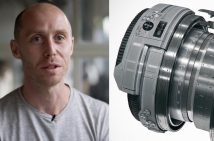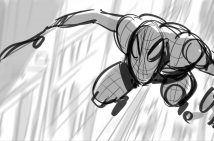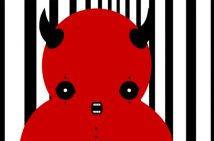Submarine Channel

Straight 8
The Straight 8 filmfestival really stands out in terms of creativity, originality and spunk. Not only it is dedicated 100% to Super 8 films, Straight 8 also challenges filmmakers with their strict set of rules. Filmmakers are allowed to use just one Super 8 film cartridge and no editing is allowed. The outcome of this are original, daring and highly imaginative films. Super 8 is old technology, certainly. Does that mean it’s obsolete? Not quite. According to Ed Sayers, founder of Straight 8 (with Ben Gregor) and director Nick Scott it’s all about the magic that happens on the film set.
How did Straight 8 start?
Ed: I started Straight 8 in 1999 and it has become a kind of… I call it a monster sideline hobby from hell. It just started from asking a bunch of people that I knew if they fancied us all trying to make a film, each one on a single cartridge of Super 8, and then getting together to view the results, with everyone seeing their film for the first time ever together. Most of the people who did it the fist time were DOPs (director of photography), editors, actors, directors, and junior people like runners, but also supposedly uncreative people like producers. A lot of them had never made a film before but everybody really worked for it, and they were very daring with their films. Now, most of the people that enter I never met. It’s just a huge word of mouth thing that happened. Now we get to know all these new great people and we get to do events like at the Cannes film festival. We met people like Nick who’s made Straight 8 films a couple of years in a row.
What is the appeal of Super 8 film?
Nick: The biggest appeal is definitely the challenge. People do different things with the Straight 8, but with the two films that I’ve made I tried to tell a narrative in the time that I had, which is pretty difficult when you have to plan the beginning, middle and end quite meticulously. Because of the nature of the competition, you’re actually forced to really deal with your content and your story. You know, digital has been great in terms of giving a lot of people access to cameras and editing equipment. It’s made it all so much easier, but sometimes it can be a bit too easy. You can just keep the camera rolling and not really think about what you’re actually trying to achieve. The good thing about Straight 8 is that it actually forces you to commit to particular shots and I think that’s why the films tend to be better. I guess the attractive thing is that everyone has the same film stock, so it comes down to the strength of your idea. And that’s certainly one of the reasons why it appeals.
Ed: The other thing about it is that it’s film and it does look fantastic. There’s that certain magic when you’re filming and you hear the film going through the camera – knowing that each time that happens you’re actually making your edit is terrifying and thrilling at the same time. And so, especially when we project as we do in Cannes from an actual Super 8 projector, you know that very same strip of 8mm film that’s going through the camera as you shoot, it goes through the projector and that’s an amazing feeling.
Your actors are never gonna get bored because you can only do one take of everything. So the whole shoot becomes quite a theatrical exercise. It keeps a certain energy going that remains on set. I think all the best feature films, especially first features, are done under difficult circumstances. There’s never quite enough money or time. Those first films often are the best ones that filmmakers make. And I think when you do a Straight 8 film there’s an element of that because everyone is pulling together.
Is there a future for Super 8 film?
Ed: As long as it remains financially viable for the manufacturers, which I think is basically just Kodak. I think that for all the people who’ve got a digital camera, from amateurs to nearly professional filmmakers, very often it hasn’t really pushed them to make a film. A lot of people think, if I get a digital camera I’ll do all this stuff and I’ll experiment and very often it doesn’t happen. With a roll of film, you have to be a bit more choosy about what you shoot even if you’re not entering Straight 8. You don’t wanna waste the film because it costs money to get it processed. It’s not like a DV tape you can rewind and use it again or whatever. There’s a different discipline on a set with a film camera and I hope that value will remain. The more people that learn that about Super 8 realize that added value you get from it. And you can’t really put your finger on it. Plus of course it still looks fantastic, you get this great depth of focus, and just the way the optics work is so different from a digital video camera. We stay in touch with Kodak a lot. Because once the film stock runs out, Straight 8 will not be the same again obviously. Kodak is still putting money behind it and is still pushing it.
Nick: I agree with Ed, there’s definitely a kind of warm nature to Super 8 that you cannot replicate. I think they used Super 8 in the beginning of ‘The Game’ with Michael Douglas. It’s a very good effect. He’s reminiscing about his childhood and only real Super 8 can give you that effect. The digital plug-ins that try to replicate Super 8, I think that looks terrible.
What is a Straight 8 event like?
Nick: I think it’s great. There’s a kind of nervous energy. You’ve got a room full of people who… Well, they’ve been selected so they kind of know that their film’s all right, but they’ve got no idea really what it looks like. In both cases, when the two films I made got shown, the actors really didn’t have a clue what the hell was going to happen. And there’s also quite a nice supportive atmosphere from people who have done particularly ambitious shots or maneuvers. They usually get a big round of applause because those shots are always a massive risk. It’s another level of appreciation and all that kind of ads up to create an exciting and unique atmosphere.
Can anyone enter Straight 8?
Ed: The entry time will be around December, which means that from that point, people from anywhere in the world can buy entry via the Straight 8 website. And then they’ll get sent their film as soon as they enter. The cut-off for answering is around February, and then the films have to be shot and the seperate soundtrack on a CD come back to us unprocessed by the beginning of March. That gives us a couple of months to get everything processed and screen it privately to ourselves. We select what goes into the Cannes film festival in May, which is always the first unveiling of the best ones. And then what tends to happen is, through he summer there’ll be a number of other screenings. Foreign screenings as well. We’ll also be producing a second DVD with the best of this year, which, eh… Nick willl be including your one on, if that’s allright with you?
Nick: Fantastic dude.
Ed: And that‘ll come out in December as well. So if people wanna get it in order to get inspired or get scared they can get that.
See Nick Scott’s Earth to Earth and The Other Half Straight 8 films.



